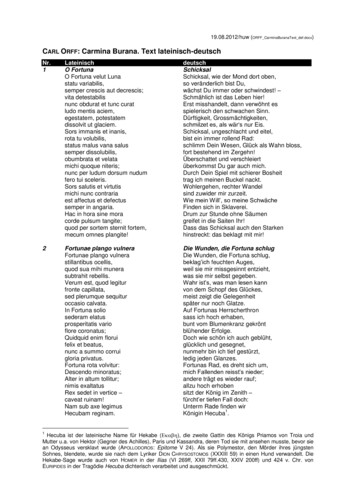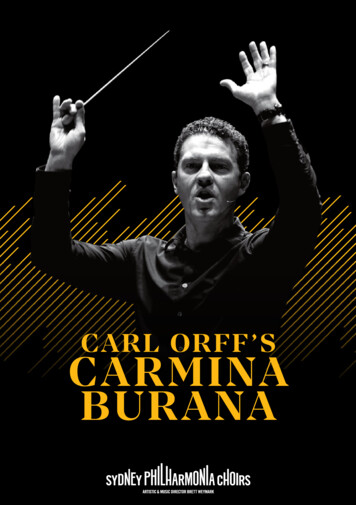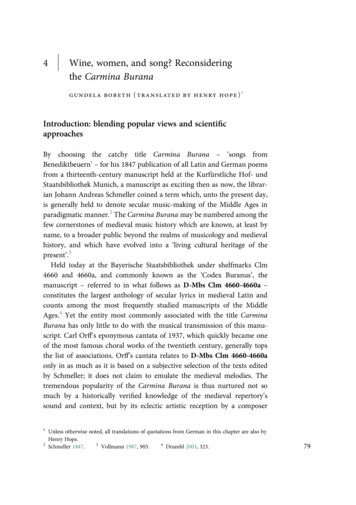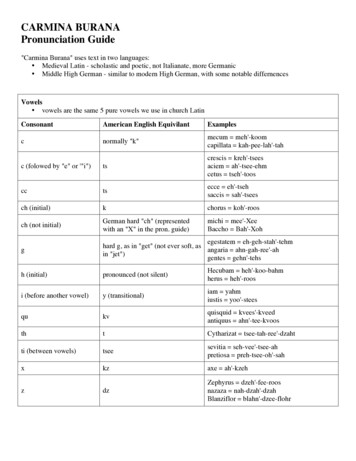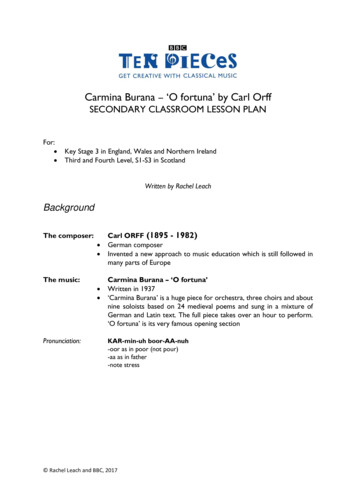
Transcription
Carmina Burana – ‘O fortuna’ by Carl OrffSECONDARY CLASSROOM LESSON PLANFor: Key Stage 3 in England, Wales and Northern IrelandThird and Fourth Level, S1-S3 in ScotlandWritten by Rachel LeachBackgroundThe composer: The music: Pronunciation:Carl ORFF (1895 - 1982)German composerInvented a new approach to music education which is still followed inmany parts of EuropeCarmina Burana – ‘O fortuna’Written in 1937‘Carmina Burana’ is a huge piece for orchestra, three choirs and aboutnine soloists based on 24 medieval poems and sung in a mixture ofGerman and Latin text. The full piece takes over an hour to perform.‘O fortuna’ is its very famous opening sectionKAR-min-uh boor-AA-nuh-oor as in poor (not pour)-aa as in father-note stress Rachel Leach and BBC, 2017
Learning outcomesLearners will listen and reflect on a piece of orchestral music create their own pieces of music using instruments and voice perform as an ensemble learn musical language/ notation appropriate to the taskCurriculum checklist play and perform in solo and ensemble contexts, using their voices and playingmusical instruments musically, fluently and with accuracy and expressionimprovise and compose; and extend and develop musical ideasuse staff and other relevant notations appropriately and accuratelyidentify and use the interrelated dimensions of music including use of tonalities,different types of scalesGlossary of music terms usedCrescendoMelodyOstinatoPulseTempogradually getting louder (opposite: decrescendo or diminuendo)another word for ‘tune’. A sequence of notes, like a musical sentencea repeating (often rhythmic) patternthe steady ‘beat’ under much music made up of notes of the samelength (like a ticking clock)another word for speedResources required A large, open spaceClassroom percussion instruments and any other instruments your students mightbe learningRecording equipment (not essential) Rachel Leach and BBC, 2017
This scheme of work is plotted out over six lessons. Feel free to adapt it to suit yourstudents and the resources you have available.The six lessons at a glanceLesson 1:Activities:Watch the film and discussListen and create new lyrics in response to the musicCreate words inspired by the musicCurriculum link:Identify and use the interrelated dimensions of music expressively andwith increasing sophistication, including use of tonalities, differenttypes of scales and other musical devicesListen with increasing discrimination to a wide range of music fromgreat composers and musiciansDevelop a deeper understanding of the music that they perform andto which they listen and its historyLesson 2:Activities:Learn and perform complex minor chordsInvent bassline and structureCurriculum link:Play and perform in a range of solo and ensemble contexts using theirvoice, playing instruments musically, fluently and with accuracy andexpressionImprovise and compose; and extend and develop musical ideas bydrawing on a range of musical structures, styles, genres and traditionsIdentify and use the interrelated dimensions of music expressively andwith increasing sophistication, including use of tonalities, differenttypes of scales and other musical devicesLesson 3:Activities:Invent, orchestrate and perform pulseLearn about and perform a crescendoCurriculum link:Play and perform in a range of solo and ensemble contexts using theirvoice, playing instruments musically, fluently and with accuracy andexpressionImprovise and compose; and extend and develop musical ideas bydrawing on a range of musical structures, styles, genres and traditions Rachel Leach and BBC, 2017
Lesson 4:Activities:Invent and perform ostinatosCurriculum link:Play and perform in a range of solo and ensemble contexts using theirvoice, playing instruments musically, fluently and with accuracy andexpressionImprovise and compose; and extend and develop musical ideas bydrawing on a range of musical structures, styles, genres and traditionsLesson 5:Activities:Invent lyrics and melodyBegin to structure ideas into a pieceCurriculum link:Play and perform in a range of solo and ensemble contexts using theirvoice, playing instruments musically, fluently and with accuracy andexpressionImprovise and compose; and extend and develop musical ideas bydrawing on a range of musical structures, styles, genres and traditionsLesson 6:Activities:Structure all ideas into a piecePerform on pitched and unpitched instruments and voice to anaudienceUse technical terminology where appropriateCurriculum link:Play and perform in a range of solo and ensemble contexts using theirvoice, playing instruments musically, fluently and with accuracy andexpressionImprovise and compose; and extend and develop musical ideas bydrawing on a range of musical structures, styles, genres and traditions Rachel Leach and BBC, 2017
LESSON 1Watching and listening1. Prepare your classExplain to your class that you are going to begin a 6-week music project focusing onan important piece of music by a composer called Carl OrffExplain further that Orff was a German composer whose life spanned the 20thcentury. His most famous piece is ‘O fortuna’. Warn your students that it mightalready be strangely familiar to them!2. Watch the film & discussWatch the Orff Ten Pieces film and afterwards invite your class to discuss its themesYou might like to have a further discussion about the concept of ‘fate’ and the ideathat life is mapped out before us and there is little we can do to change it. This mightbe something your students haven’t thought about before. Quickly split them intosmall discussion groups and ask them: ‘do you believe in fate?’ Pick up also on theidea of a ‘Goddess of Fate and Fortune’ called “Fortuna” who has the power todecide everyone’s fate and her ‘wheel of fortune’ constantly spinning out good andbad luck3. Listening task.Listen to the opening 25 seconds of ‘O fortuna’ again. You can either watch thevideo clip of the full performance of the piece or listen to the audio by downloadingthe mp3.Orff makes three big musical statements. The first is, of course, ‘O fortuna’. Askyour students, working individually, to create new words for these three musicalstatements. Explain that this should be a cry to the Goddess of Fortune and Luck.You might like to challenge them further to make these lines rhyme.4. Choose some of these lines and have fun trying to sing them along with thebeginning of the recording – loudly! Rachel Leach and BBC, 2017
5. Give out A4 paper and ask your students to create two columns on their pageand head them ‘good luck’ and ‘bad luck’, like this;GOODLUCKBADLUCKAs you listen to ‘O fortuna’ again (in full), challenge your class to fill up the columnswith suggestions for good and bad luck. You might like to ask for these suggestionsto be fun/ serious/ surrealist/ poetic etc. because later in the project these ideas willform lyrics6. FINALLY – end your suggestion with another discussion. Ask your students toshare their ideas and perhaps create a class list. Save these ideas for future use. Rachel Leach and BBC, 2017
LESSON 2Introduction1. Being with a quick reminder of the last lesson before explaining that you aregoing to begin work on recreating Orff’s piece on instruments. Don’t play therecording at this point, this lesson is all about recreating, not copying, theintroductionOrff’s introduction is simply a move between two chords – D minor and A minor(or major - Orff leaves this ambiguous)2. Everyone needs an instrument for this. Work as a full class in a big circle ifpossible. Ask your students to find a D minor chord and an A minor chord. To dothis, simply ask them to choose one note from each of the following:3. When this is achieved ask them to ‘blur’ the chords by swapping in a couple ofextra (clashing) notes. For example, Orff adds an E to his D minor chord, and takesout the 3rd of A minor replacing it with the 4th (so C becomes D)Again, the best way to do this is to ask students to choose the notes for themselveswithout too much discussion, hear what you’ve got and tweak it if you need to4. Take a moment to focus on the bassline. Orff’s D minor chord is underpinned by adramatic falling bassline. Can you add this to your class piece? His A chord isunderpinned by an octave leap – experiment with this too Rachel Leach and BBC, 2017
5. Split the class into small composing teams and ask them to make three big musicalgestures that are as follows: Gesture 1 & 2: D minor chord, with added notes and falling basslineGesture 3: An ambiguous A chord (no 3rd but added notes) and anoctave leap in bass6. Bring the groups back together, hear what they have created and give somefeedback. Can they work out a way to make one big introduction by joining theirgroup pieces together? Do they want to include some of the words from last lessonsung over the top?7. FINALLY – end this session with the groups writing down what they have done.They might want to jot this down as a list of events, or make a diagram or a graphicscore Rachel Leach and BBC, 2017
LESSON 3Pulse1. Remind your students of their work last lesson. Give your composing teams afew minutes to remember what they did because you are not going to revisit theintroduction this week, you are going to move on to the main body of the piece.2. Orff has a steady, slow ‘um-pa’ rhythm going throughout his piece which sounds likean army marching endlessly forward. Clap a steady pulse and encourage yourstudents to join in.If you notice one or more students can’t do this and keep rushing ahead or are going at acompletely different speed, simply ignore them. We all find our sense of rhythm at a different stage- maybe they just haven’t found theirs yet!3. Explain that you need two slightly contrasting sounds for your pulse. Can theysuggest two different sounds on their bodies. They might suggest a knee-hit and a clapPractise your pulse by alternating between these two sounds. For example -4. Instruments - ask the students to find two slightly contrasting sounds for this ‘umpa’ pulse using their instruments. Pitched instruments should use just two pitches D and A.5. Gradually add in more ideas and instruments until everyone has something. Ifyou don’t have enough instruments to go around keep one group on bodypercussion or give them leadership roles such as starting and stopping others.6. Split into groups and challenge each team to create a pulse piece with acrescendo, they must gradually get louder but the tempo (speed) must remainconstant, just like in Orff’s version. Rachel Leach and BBC, 2017
7. Bring the groups back together and hear each piece. Who has the mosteffective crescendo?8. Structure. Ask the students to structure their group pieces together to make onebig piece with a crescendo. They must also work out how to start and stop, how tobegin and come in. Maybe they need to appoint a conductor 9. FINALLY – have a go at putting this big crescendo after the introduction made lastweek and again, ask your students to keep a record of what they have done, whoplayed what and the order. (They could add this on to the graphic they created lastweek) Rachel Leach and BBC, 2017
LESSON 4Ostinato (repeating patterns)1. Warm-up – quickly recap your pulse piece from last week. If it was wonky at theend of the last session or kept speeding up now is a good time to straighten it out2. Explain that you are going to make some repeating rhythmic patterns to go ontop of your pulse. The ‘posh’ word for repeating rhythmic pattern is ostinato.One of the best ways to create ostinatos with students is to use words. Here is asimple method which you can use as a warm-up for your session –a. Ask your class a simple question such as ‘what’s the luckiest thing that everhappened to you?’b. Choose one student, or a small group, to play the pulsec. Ask your class to speak their ‘good luck sentence’ on top of the pulse tryingto make the words fit and repeating them round and around.d. Ask your students to perform their ostinatos on body percussion rather thanspeaking them (i.e. one sound for each syllable)3. Split your class into small composing teams and, using the same instrumentsas last lesson, set the following task – Make a short SLOW piece that includes:i.The steady pulse from last session (pitched on D & A, or unpitched,or both)ii.ONE ostinato that is played by everyone elseThe pitches for the ostinato are:These are the same pitches Orff uses in his piece - all the way through! If they are problematic foryour students, ask them to choose their own pitches but limit them to just 3 or 44. Bring your class back together and hear each piece. Give feedback: did theystick to the rules? Are they keeping a slow, steady tempo (speed)? Can you hearthe ostinato and the pulse? Rachel Leach and BBC, 2017
5. Challenge your students to put all their pieces together to make one big piece. Todo this they must work out a way to add the ostinatos to their pulse piece from lastweek so students are going to have to decide which role they perform. They mustalso and keep the crescendo6. FINALLY – end your session with a performance of your piece so far and as usualleave a moment for notation Rachel Leach and BBC, 2017
LESSON 5Words and melody1. Prepare the class. Encourage your students to get back into their composingteams and get their instruments out. Give out the ‘good luck/ bad luck’ sheets fromthe listening task in lesson 1. These are going to be the inspiration for lyrics.2. Ask each group to select ideas from their lists and create up to 8 lyric lines. Hereare some tips for creating lyrics: Short lines and words work best (avoid unnecessary words and words withmultiple syllables) Lyrics don’t have to rhyme but if you start a rhyming scheme, you shouldcontinue it throughout Go for an even number of ‘good’ and ‘bad’ luck lines (i.e. four of each)3. Pulse – challenge each group to speak their lines to the D & A pulse.4. When this is done, hear some of the l
Carmina Burana – ‘O fortuna’ by Carl Orff SECONDARY CLASSROOM LESSON PLAN For: Key Stage 3 in England, Wales and Northern Ireland Third and Fourth Level, S1-S3 in Scotland Written by Rachel Leach Background The composer: Carl ORFF (1895 - 1982) German composer Invented a new approach to music education which is still followed in many parts of Europe The music: Carmina Burana – ‘O .
